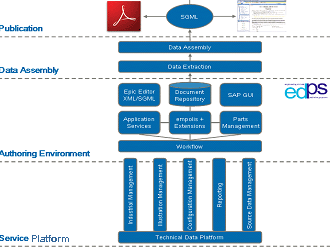Airbus's Super Jumbo Content Challenge
Fine-Grained Information Objects, Variants, and Layered Architecture Form the Solution
When Airbus began work on the A380 Superjumbo aircraft, it also began work on building a new documentation system, one that could support a million pages of custom documentation for each aircraft and a thousand people developing the content. Axel Sellmer, Manager IS for Repair and Customer Services Germany, and his team developed the software and systems for technical documentation. This report describes the exacting requirements of the A380 documentation projects, and the systems Axel’s team developed to satisfy those requirements, which includes a layered technology architecture and an atomic information architecture.
Distribution Sponsored by empolis GmbH
NETTING IT OUT
Airbus, producer of Airbus airliners since 1970, is a multinational division of EADS employing 57,000 people in France, Germany, Spain, and the UK. When Airbus began work on the A380 Superjumbo aircraft, it also began work on building a new documentation system. The PDF files and paper used for past airliner documentation could not adequately address a product that would require over a million pages of customized documentation and a thousand people in four countries developing the content.
Axel Sellmer, Manager IS for Repair and Customer Services Germany, and his team of 15 staff and about two dozen external experts, developed the software and systems for technical documentation for all of Airbus. This new system has a layered technology architecture and an atomic information architecture. Together, these architectures support the wide distribution of workers and the high degree of scalability demanded by the A380 documentation projects. This report describes the exacting requirements of the A380 documentation projects and the systems Axel’s team developed to satisfy those requirements. We’d like to acknowledge and thank Axel Sellmer for all his help in providing information and insight for this report.
AIRBUS: PRECISION PRODUCT, PRECISION DOCUMENTATION
Introduction to Airbus
The aircraft known as the Airbus was first created in 1970. As of December 2007, there were 4,794 in operation out of 5017 delivered. An Airbus model has a long life: the A300 was introduced in 1972, and the last one was manufactured in 2007. Individual aircraft may be in commercial service for five decades or more.
Airbus itself is a division of the European Aeronautic Defense and Space Company, which has 116,805 employees in France, Germany, UK, Spain, USA, and other countries. Airbus operates from satellites in four countries: France, UK, Spain, and Germany. It has 57,000 employees. Factories in all four countries produce sections of the aircraft, which are brought to Toulouse, France for final assembly. In 2007, Airbus shipped 453 aircraft.
A380: Debut of Highly Complex Product
The A380 is Airbus’s super jumbo aircraft. The world’s largest civil airliner, with a takeoff weight of 590 metric tons, it can carry 525 passengers and has a range of 15,000 kilometers. The first aircraft entered production in January 2002; in October of 2003 all parts were transported to Toulouse for assembly; and in March 2005 Singapore Airlines pilots made their first A380 test flight. The first customer delivery of an A380 was to Singapore Airlines in October 2007. Today there are 187 on order, and two have been delivered to Singapore Airlines.
In round numbers, the A380 is comprised of millions of parts, provided by 3,000 suppliers; there are 100 major assemblies in an aircraft.
Each aircraft must, by regulatory fiat, be accompanied by comprehensive documentation. The scope and structure of this documentation is stipulated in an industry standard, which describes roughly 100 manuals for the repair and maintenance of each aircraft. The documentation for a single aircraft model is so voluminous that, if printed, its weight would require two airliners to transport it.
Documentation Platform for the Repair Domain

© 2008 empolis
Illustration 1. The documentation platform for the Repair Domain is comprised of four main layers: the foundational Service Platform, and, above it, the Authoring Environment, Data Assembly, and Publication.
SUPERJUMBO DOCUMENTATION
Goals for Documentation System
ATA Specification iSpec 2200 is the industry standard that dictates the format and structure of digital documentation for an aircraft. The ATA is the Air Transport Association, an industry group whose members are airlines and airline suppliers. The 100 manuals align with the aircraft structure, with one for each of the major assemblies. Documentation is divided into two interrelated domains: repair and maintenance. The documentation must be tested and certified, and delivered to customers in SGML,
Having 100 printed manuals on hand, each containing as many as 50,000 pages, requires substantial space; dedication to constant filing of updates; and the leisure to flip through pages looking for the right information. None of these criteria are likely to be met in a repair hangar. As a result, fleet operators have developed online systems that deliver repair information on all types of aircraft to maintenance workers. These online systems must import documentation from aircraft manufacturers and other suppliers.
In 1999, coinciding with the launch of the A380, Airbus launched initiatives to operate its four independent units as a unified company. It began developing common policies, methods, and processes to be used across Airbus. Documentation was one of the first arenas to be addressed. A common platform and common processes used by all of Airbus and its suppliers would deliver great efficiency, meet customer requirements for standardized format and delivery for all Airbus documentation, integrate and harmonize Airbus processes, establish a state-of-the-art documentation platform, and improve the reliability and scalability of documentation development and delivery.
Airbus also made it a goal to eliminate paper documentation. Printing, delivering, and using paper, or paper equivalent (such as PDFs), was just no longer practical or effective. Even though PDF files do not create the storage and delivery problems of paper, they are not easily managed in large numbers. The problem of managing paper is merely replaced by the problem of controlling file versions and electronic storage. Updating a page in a manual requires creating an entire new file. The old file must be located and removed; the new file must be stored in the appropriate location. Any errors in this process could result in improper repair or maintenance of aircraft. A more foolproof, flexible, and scalable approach was critical.
Given the high degree of regulation, the actual documents can’t differentiate Airbus’s product. But the process of creating and distributing the documentation could differentiate the product in terms of how quickly updates are delivered and whether the information is tailored for the fleet or customizable for the individual airliner.
Superjumbo Challenges
The vast scale of the A380 documentation, its complexity, its rate of change, its customization, its integration with customers’ repair information systems, and regulatory requirements pose daunting challenges. These challenges drive stringent requirements for the documentation system.
SCALE. The documentation for the A380 is well over a million pages and approaches 50 gigabytes. It addresses every single part and assembly and covers every repair, damage assessment, test, and maintenance action that can be taken on the A380. The 100 manuals, some of which are 50,000 pages or more, must all be complete, tested, and certified before an aircraft can be shipped to a customer. Scalability drives requirements in the following key areas...
Sign in to download the full article
0 comments
Be the first one to comment.



